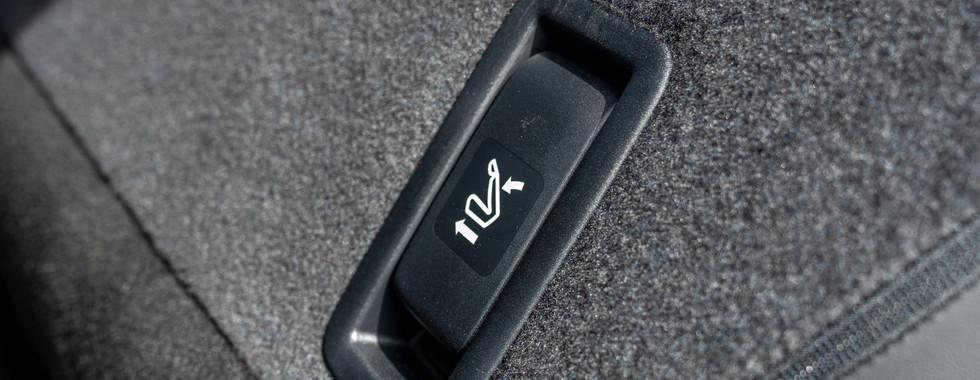Face-off between the Lexus TX350 and the Infiniti QX60, champions of Japanese luxury.
- Marc Gonzalez

- Sep 5, 2024
- 5 min read
When shopping for a luxury vehicle, people often think of Old Continent manufacturers, but the Lexus TX350 and Infiniti QX60 are solid contenders from the Japanese automakers. Lexus is trying to make a real impact in the three-row SUV market, while Infiniti hopes to win back customers. The Lexus TX350 Executive 7-passenger AWD had an MSRP of $82,422.50 and was built in Princeton, IN, while the Infiniti QX60 Autograph AWD had an MSRP of $76,736 and was built in Smyrna, TN.

Design-wise, the Nagoya-based automaker made the Lexus TX very angular and boxy. It's got character, especially at the front, with its multi-layered grille and boomerang LED daytime running lights. The profile and back of the vehicle are just as striking as the front, and the athletic look gives it a different vibe from other models in the segment. The 22-inch F Sport wheels are massive and contribute to the sporty look. On the other hand, the Infiniti QX60 takes a different approach in terms of the overall design, with the trapezoid-shaped front grille, a rounder look from all sides and a discreet rear area. The combination of Deep Bordeaux with a black roof looks excellent, and the 20-inch 'Luxury' aluminum wheels have a good-looking combination of black and grey accents. These two vehicles are shaped differently to better target different types of buyers.

Stepping into the Lexus TX doesn't feel like any other Lexus from years past. They have stepped up their game regarding interior quality, and the TX is a great example. The gauge cluster, steering wheel, and door assembly feel upscale and luxurious. Starting on the driver's side, you will find the new 12.3-in multi-information display, much more configurable than before. In the center console, you will find the new Lexus interface on a 14-inch touchscreen, which is being implemented in other Lexus models. And the touchpad is gone! The screen is large and responsive, with wireless Apple CarPlay and Android Auto, and you can quickly switch between menus and the map, for example. The only thing we'd change is to have physical buttons for the climate controls. The good news is that the temperature is still on the knobs, along with the defogger and rear defroster. When you press the Auto Climate button, the Climate Concierge will activate the heated or ventilated seats, a feature that should also be available on other luxury models. Seven USB ports are spread throughout the three rows of seats, and the Mark Levinson 21-speaker sound system could sound better than other Lexus models.
Infiniti QX60 AUTOGRAPH interior:
The interior of the new QX60 aims for luxury but left us wanting more. The 12.3-in digital gauge cluster is nice and configurable but lacks features like a full-screen map. The steering wheel has leather wrapping, but the buttons on each spoke lack refinement as they play an integral part in the daily routine. As you move toward the central infotainment system, you'll find a 12.3-inch touchscreen. The only annoying thing is that only about two-thirds of the menu shows wireless Apple CarPlay. The right side of the screen mainly shows the current song or the time. Also, you can only use Android Auto when the phone is plugged in. The center console features a knob which allows you to control the touchscreen display from the central storage compartment. On the flip side, the climate control panel is easy to use and looks friendly, with the buttons lit up in yellow/orange. The cabin has six USB ports, and all QX60 trims have a wireless charger. The Lexus is no exception. On the plus side, the Bose 17-speaker sound system is pretty good.
Lexus TX350 interior:
The Lexus TX350 and Infiniti QX60 have a standard capacity of 7 passengers or 6 with the captain chairs in the second row. The Infiniti features plush quilted leather seats with embroidered Autograph on the first and second rows, providing superior comfort to the Lexus. Not to say that Lexus' seats are uncomfortable, but the Yokohama-based automaker takes the crown in terms of comfort. Although the third row is small, the Lexus TX and Infiniti QX60 offer easy access to it thanks to buttons on the second row. The third row can accommodate children and teenagers without them feeling cramped. Unfortunately, the seats have to be manually folded down in the QX60 with the latches and straps for the third row, although the electronic controls are present in the trunk to lower the captain chairs in the second row. The TX has power folding seats, even in the third row, which are easily folded and raised. On the flip side, the ISOFIX ports are easily accessible on both rear rows of seats in the Infiniti, while the Lexus is easy to locate on the second row; in the third, the pictogram to locate them is present, but you have to feel them to reach it. Finally, both family SUVs have the rear anchors within reach of the parent fitting the car seat.

Regarding power, the Lexus TX350 and Infiniti QX60 have taken different approaches. Lexus has a turbocharged 2.4L 4-cylinder engine paired with an eight-speed automatic transmission. The combination delivers an adequate 275 hp and 317 lb-ft of torque, which adds up to an estimated 7.1 seconds to go from 0 to 100. Infiniti has gone with a well-known engine in the Nissan/Infiniti lineup, the naturally aspirated 3.5L V6, for the QX60. The old CVT has been replaced with a new nine-speed automatic transmission that sends 295 hp and 270 lb-ft of torque to the wheels. The QX60 reaches 100 kph in about 6.2 seconds, about a second faster than its competitor. Both vehicles offer all-wheel drive on all trims. Lexus also provides two additional hybrid powertrains, including a plug-in hybrid version. Infiniti has the edge regarding towing capacity, with a further 1,000 lbs over its rival (6,000 vs 5,000).
Lexus TX350:
On the road, the Lexus TX and Infiniti QX60 drive somewhat similarly. They are both large family-oriented SUVs focused on comfort rather than performance. The Lexus TX350 has decent power, but it still feels tight due to the sheer weight of the vehicle; at over 2.7 tons (6,128 lbs), the TX is heavy. The 22-inch wheels slightly impact the ride quality; it would be quieter with the standard 20-inch. Braking was disappointing; the pedal is long and doesn't inspire confidence; fortunately, the Proactive Driving Assist, which uses the camera and radar system, scans the vehicle's surroundings and gently brakes to keep a safe distance from the car in front and curves. The system's application is seamless and doesn't feel overly assisted, which is excellent! The suspension is tuned for comfort; you sit quite high and barely feel the bumps on the road. Finally, the steering and handling are average in such a vehicle; there's some body roll in curves and weight shifting in acceleration and braking, but maneuvering parking situations is easy thanks to its light steering. As for the QX60, most of the comments above also apply to Infiniti, with the significant difference being the power distribution, which is more direct and connected to the powertrain. Also, when you stomp your foot on the accelerator, the V6 has a more throaty sound than the Lexus, and you hear it more in the cabin. Otherwise, the brake pedal feels long, although not as much, and the suspension is tuned for comfort. Overall, they both feel comfy and luxurious.

The Lexus TX and Infiniti QX60 are excellent options in the midsize luxury SUV segment. Lexus finally has a proper three-row SUV, spacious enough for 6 or 7 passengers, while Infiniti has refined its vehicle to remain competitive. Lexus is known for its high-quality craftsmanship and smooth ride, and the TX is no exception. Infiniti has some excellent materials, although the screen situation should be better at this price point. Ultimately, it boils down to certain specific points, with which Lexus takes the crown of today's showdown. Would you have made the same decision?

Lexus and Infiniti have lent us this vehicle for one week as a press vehicle. We have no affiliation with Lexus and Infiniti Canada. The above reflects our personal opinion of the cars referred to above.


















































Comments